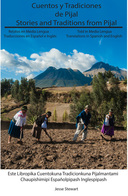Media Lengua
Media Lengua (ML) is a contact language, sometimes referred to as a mixed language, spoken in the Ecuadorian highlands. In the contact language literature, Media Lengua is well known for its lexicon-grammar split where nearly all Quichua-origin lexical roots, including core vocabulary, are replaced by their Spanish counterparts through various processes of lexification (relexification, translexification, & adlexification). Impressionistically, the Spanish-derived lexicon in Media Lengua appears to conform to Quichua phonology while maintaining Quichua word order and the vast majority of Quichua’s agglutinating suffixes. Example (1) illustrates a typical PML sentence. The italicized elements are derived from Spanish:
(1) si no aseti-ta okupa-kpika uebo-ka if not oil-acc use-SUBJ.DS egg-TOP saɾten-pi-mi pega-ʃpa keda-n. pan-loc-val stick-sub.ss remain-3 ‘If you don’t use oil, the egg will stick to the pan.’ Little acoustic or psycholinguistic work has been conducted with mixed languages. However, these languages hold a wealth of information which could be used to better understand the sociological, psychological, and cognitive factors that allow humans to take two typologically unrelated, fully functional languages, split them apart and create a new, fully functional language based on different linguistic components with little blending from each source language. Online Analytical Tools We are currently working on a number of online tools for learning and analysing Media Lengua and Quichua. These include (1) the Media Lengua dictionary, which is continuously updated unlike the published version, (2) a grammatical parser designed to parse Media Lengua and Community Quichua sentences into their component morphemes. Results appear in IPA and contain basic translations in Quichua, Spanish, and English, and (3) a verb conjugator which inflects verbs in various tense, aspects, and modalities. The latter has options for Media Lengua, Pijal Quichua, and Unified Kichwa. These tools are currently hosted on GitHub and are still in their beta versions. LINK |
 Stories and traditions from Pijal is a collection of narrations from the community of Pijal, Ecuador. This is the first published document in Media Lengua. Available through various outlets including: Amazon.com, Amazon.es, CreateSpace.com in color or black and white *New* Now available for free through Academia.edu and Researchgate.net Media Lengua on Wiki
|
My research
My research is primarily aimed at the production and perception of conflicting areas of phonological convergence from the opposing source languages' sound systems (phonemic conflict sites). I typically rely on empirical research over theoretical and make use of acoustic, psycholinguistic, and statistical analyses to support my findings. Through my research, I hope to shed some light on how our brains deal with extreme language contact, language compatibility, and language genesis. Media Lengua spoken in Pijal is my primary language of interest, but I have recently begun to expand my my research to other mixed languages such as Michif spoken in the Canadian prairies and Gurindji-Kriol spoken in the Victoria River District of Australia.
Language samples
The audio clip below is a brief sample of the Media Lengua language spoken in Pijal. The recording was producing during an elicitation session where the speaker was asked to orally translate Spanish sentences.
Be sure to turn on your closed captions (the CC button). You can select from, Media Lengua, Quichua, Spanish, English, French, Portuguese or Italian.
Language samples
The audio clip below is a brief sample of the Media Lengua language spoken in Pijal. The recording was producing during an elicitation session where the speaker was asked to orally translate Spanish sentences.
Be sure to turn on your closed captions (the CC button). You can select from, Media Lengua, Quichua, Spanish, English, French, Portuguese or Italian.
The following audio sample is a narrative told in Media Lengua entitled Jilana 'Spinning Wool'.

